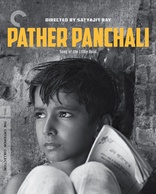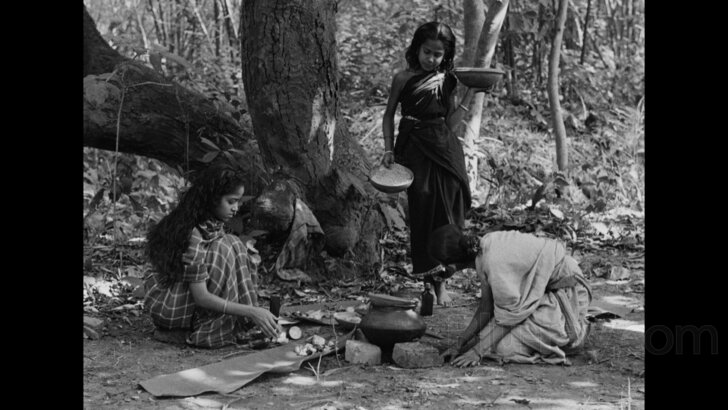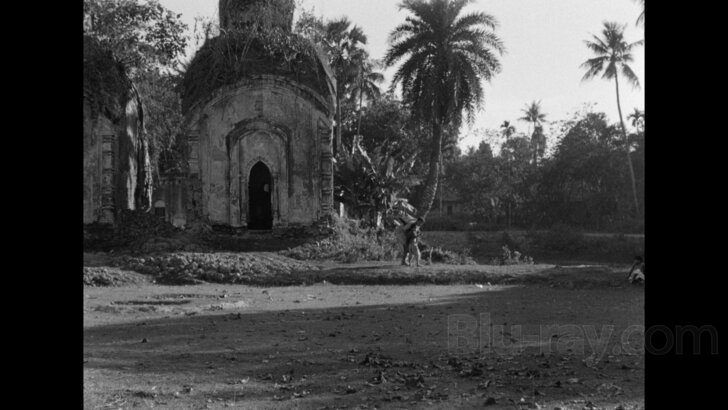Pather Panchali 4K Blu-ray Movie
HomePather Panchali 4K Blu-ray Movie 
পথের পাঁচালী / Song of the Little Road / 4K Ultra HD + Blu-rayCriterion | 1955 | 126 min | Not rated | No Release Date

Price
Movie rating
8.3 | / 10 |
Blu-ray rating
| Users | 0.0 | |
| Reviewer | 4.5 | |
| Overall | 4.5 |
Overview
Pather Panchali 4K (1955)
Impoverished priest Harihar, dreaming of a better life for himself and his family, leaves his rural Bengal village in search of work. Alone, his wife, Sarbajaya, looks after her rebellious daughter, Durga, young son, Apu, and Harihar's elderly aunt, Indir. The children enjoy the small pleasures of their difficult life, while their parents suffer the daily indignities heaped upon them.
Starring: Kanu Bannerjee, Karuna Bannerjee, Chunibala Devi, Uma Das Gupta, Subir BanerjeeDirector: Satyajit Ray
| Drama | Uncertain |
| Foreign | Uncertain |
Specifications
Video
Video codec: HEVC / H.265
Video resolution: 4K (2160p)
Aspect ratio: 1.37:1
Original aspect ratio: 1.37:1
Audio
Bengali: LPCM Mono (48kHz, 24-bit)
Subtitles
English
Discs
Blu-ray Disc
Single disc (1 BD)
4K Ultra HD
Playback
Region A (locked)
Review
Rating summary
| Movie | 4.5 | |
| Video | 5.0 | |
| Audio | 4.5 | |
| Extras | 4.5 | |
| Overall | 4.5 |
Pather Panchali 4K Blu-ray Movie Review
Reviewed by Dr. Svet Atanasov February 29, 2024Satyajit Ray's "Pather Panchali" (1955) arrives on 4K Blu-ray courtesy of Criterion. The supplemental features on the release include recent interviews with actors Shampa Srivastava and Soumitra Chatterjee; recent interview with Satyajit Ray's camera operator Soumendu Roy; excerpts from the documentary film "The Song of the Little Road"; and more. In Bengali, with optional English subtitles for the main feature. Region-Free.

Note: Satyajit Ray's Pather Panchali is part of Criterion's The Apu Trilogy three-disc 4K Blu-ray box set.
There is simplicity and calmness in the visuals that remind of the work of the great Italian neorealists. The viewer is left with the impression that life simply happens before the camera -- people follow daily routines and rituals that make their existence meaningful.
The film is set in a remote village in Bengal and follows closely a small family trying to make ends meet. The head of the family, Harihar (Kanu Bannerjee), is a free-spirited poet who is convinced that it is only a matter of time before his talent is recognized, but he is so focused on his work that he has essentially abandoned it. The mother, Sarbojaya (Karuna Bannerjee), occasionally confronts him and tries to make him understand that she can’t raise alone their daughter Durga (Uma Das Gupta) and son Apu (Subir Banerjee), but appears to have accepted that he isn’t going to change. She must also take care of their elderly aunt (Chunibala Devi), who does not always agree with the way she treats Durga and Apu.
A small incident seriously frustrates Sarbojaya, and she makes the aunt feel unwanted. Soon after, she quietly leaves the family. Then Harihar leaves after he is forced to seek work in a different region. During the monsoon season, Durga also falls seriously ill.
Alone and with limited resources, Sarbojaya struggles to keep the family together. Eventually, when Harinar returns, a decision is made to leave the village and move to the closest city where life has a completely different rhythm.
Pather Panchali was Bengali master Satyajit Ray’s directorial debut. In 1955, a year after Ray completed it, the film was screened at the Cannes Film Festival, where it received rave reviews and won multiple awards.
The strength of the film is in its ability to capture the raw beauty of life without resorting to melodrama. The film welcomes the viewer into the reality of Apu’s family, and then makes it incredibly easy to sense the uncertainty that defines it. Various relationships are carefully observed, but the focus of attention is actually on the way people embrace life. (The exact same approach toward storytelling is present in the classic neorealist films of Roberto Rossellini, Vittorio De Sica, Giuseppe De Santis, Luchino Visconti, and Carlo Lizzani).
Nature has a key role in the film. It is captured in ways that force the viewer to think about the cycles of life and the decisions people make as they go through them. Death, in particular, is captured in an unusually bold (for an Indian film from the era) manner, suggesting that it is an inevitable culmination of life -- even when premature -- rather than a mystical event.
The film has a very distinctive soundtrack, but the music isn’t used to create and sustain a specific atmosphere. It blends with the sounds of nature and the existing rhythm of life. The soundtrack was created by the legendary Bengali sitar player and composer Ravi Shankar.
Pather Panchali 4K Blu-ray Movie, Video Quality 

Criterion's The Apu Trilogy box set contains 4K Blu-ray and Blu-ray copies of Pather Panchali, Aparajito, and Apur Sansar. The 4K Blu-ray discs are Region-Free. However, the Blu-ray discs are Region-A "locked".
The Apu Trilogy made its high-definition debut with this release in 2015. The 4K Blu-ray box set offers native presentations of the same 4K restorations of the three films that were introduced in the Blu-ray box set. These presentations are not graded with Dolby Vision or HDR.
Even though some very small inherited limitations remain -- which mostly affect density and sharpness/clarity -- I think that the three films in the The Apu Trilogy look sensational now. To be honest, my previous experiences with these films were such that before they were restored, I did not think that they can have proper presentations. Why? Because all DVD releases that I had seen were sourced from very weak elements, and because there were never any major efforts to properly restore them. I thought that perhaps there were no good surviving elements for them. So, when they were redone, the upgrade in quality was so dramatic that revisiting them was a borderline surreal experience.
So, how does Pather Panchali look in native 4K? And should you consider an upgrade if you already have the Blu-ray box set?
In native 4K, the entire film looks really, really good, which of course is hardly surprising. Also, given the inherited limitations I mentioned above, the dynamic range of the visuals is terrific, too. A lot of backgrounds that reveal different darker nuances and shadows, in particular, look incredibly well balanced, so I do not see how a Dolby Vision or HDR grade could have made a substantial difference. What about the move from 1080p to native 4K? Is there a significant upgrade in quality? Some visuals convey better detail and look sharper, but my overall impression is that the 1080p and native 4K presentations are quite similar. So, it would make sense to consider an upgrade only if you have a very large screen or have the ability to project, If you already have the Blu-ray box set, I think that by upscaling the 1080p presentation to 4K, you will more or less replicate the type of quality that the 4K Blu-ray release offers.
Pather Panchali 4K Blu-ray Movie, Audio Quality 

There is only one standard audio track on this Blu-ray release: Bengali LPCM 1.0. Optional English subtitles are provided for the main feature.
The overall quality of the audio is very good. However, as I previously reported, there are some areas where the audio becomes somewhat thin and even. I have to speculate that this is probably how the soundtrack was recorded. Time might have left its mark as well. The English translation is excellent.
Pather Panchali 4K Blu-ray Movie, Special Features and Extras 

4K BLU-RAY DISC
- Bonus Features - there are bonus features on the disc.
- Ravi Shankar - presented here are excerpts from the documentary film The Song of the Little Road (2003), in which the legendary sitar player and composer Ravi Shankar recalls his interactions with Satyajit Ray and discusses his directing methods as well as the music he composed for the films in The Apu Trilogy. The documentary was produced and directed by Priyanka Kumar. In English, not subtitled. (6 min).
- Sounebdu Roy - in this video interview, Soumendu Roy, who assisted Satyajit Ray during the shooting of Pather Panchali and became his main camera operator, discusses the production history of the film, the shooting process (the shoot took place in the remote village of Boral), the unique treatment of light and the important role of nature in the film, Subrata Mitra's lensing, etc. The interview was conducted exclusively for Criterion in 2013. In Bengali, with optional English subtitles. (13 min).
- Shampa Srivastava - in this brand new video interview, actress Shampa Srivastava, who plays the young Durga (credited as Runki Banarjee), remembers her interactions with her mother in front of the camera, the various instructions Satyajit Ray gave her, how different sequences were shot, etc. The interview was conducted exclusively for Criterion in 2015. In English, not subtitled. (17 min).
- Soumitra Chatterjee - in this video interview, actor Soumitra Chatterjee, who plays the adult Apu in Apur Sansar and appeared in a number of other films directed by Satyajit Ray, discusses the cinema scene in India during the 1950s and how the great Bengali director changed it. The interview was conducted exclusively for Criterion in 2013. In Bengali, with optional English subtitles. (8 min).
- A Long Time on the Little Road - in 1957, Satyajit Ray wrote an article for Sight & Sound about the maing of Pather Pinchali. Soon after, film critic Gideon Bachmann recorded the director reading his account aloud. The audio recording is presented here. In English, not subtitled. (15 min).
- Booklet - 44-page illustrated booklet featuring Tettence Rafferty's essay "Every Common Sight"; Satyajit Ray's storyboards for Pather Panchali; Girish Shambu's essay "Behind the Universal"; and notes about the 4K restoration of The Apu Trilogy.
Pather Panchali 4K Blu-ray Movie, Overall Score and Recommendation 

The 4K restorations of the three films in The Apu Trilogy are incredible. This statement may seem like an exaggeration to someone that does not have any previous experience with them from the VHS and DVD eras and is now comparing them to other 4K restorations of classic and cult films, and I can understand very well why. However, a little over a decade ago I was genuinely skeptical that these films can be properly restored because they always looked very, very poor on DVD and there were speculations that good elements for them no longer exist. Now, we have them beautifully restored in 4K and available on 4K Blu-ray, which is amazing. If you do not have The Apu Trilogy, this box set should be on your radar because it offers definitive presentations of the three films. If you already have the previous box set, I think that you should consider an upgrade only if you have a very high-end system or like to project. HIGHLY RECOMMENDED.
Other editions
Pather Panchali: Other Editions
Similar titles
Similar titles you might also like
(Still not reliable for this title)

Aparajito 4K
অপরাজিত / The Unvanquished
1956

Apur Sansar 4K
অপুর সংসার / The World of Apu
1959

The Banishment
Izgnanie
2007

Beyond the Hills
După dealuri
2012

Umberto D.
1952

The Painted Bird
Nabarvené ptáce / Slipcover in Original Pressing
2019

Fanny and Alexander
Fanny och Alexander / Television and Theatrical Versions
1982

In the Fog
V tumane
2012

Dekalog
The Decalogue
1988

The Silence
Tystnaden
1963

Manon of the Spring
Manon des sources
1986

Cemetery of Splendor
2015

Sansho the Bailiff
山椒大夫 / Sanshô dayű
1954

Three Colors: Red
Trois couleurs: Rouge
1994

Summer Interlude
Sommarlek
1951

Blind Chance
Przypadek / Uncensored Version
1987

The Big City
মহানগর / Mahanagar
1963

Julieta
2016

Roma
2018

Wild Strawberries
Smultronstället
1957
